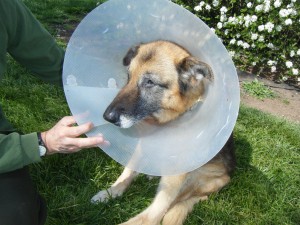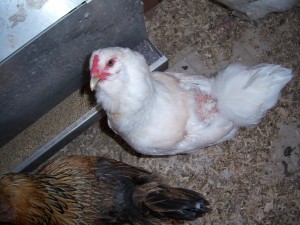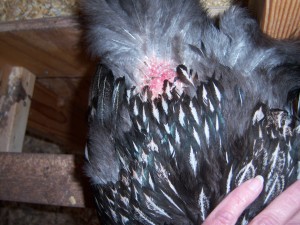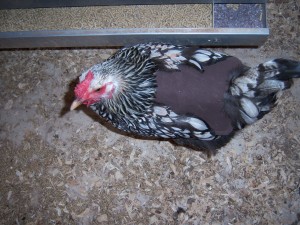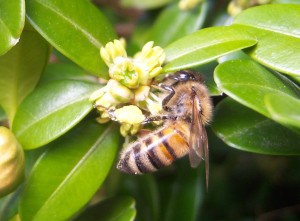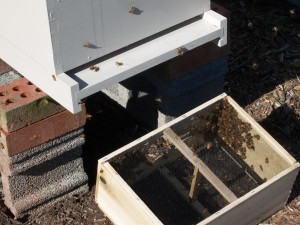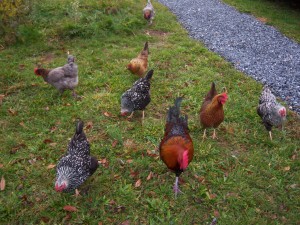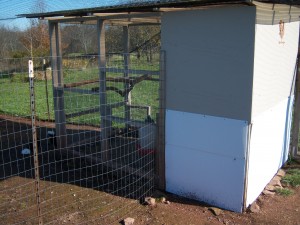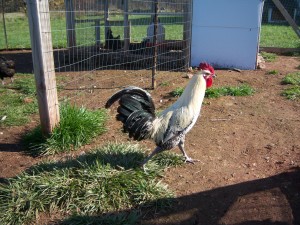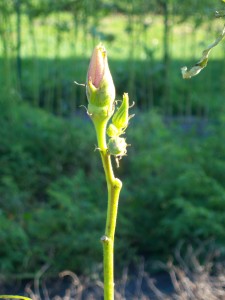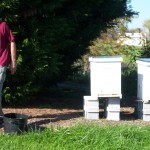
Our beautiful Ellie
1Ellie will be 14 in May and our poor girl is having some struggles. She has degenerative myelopathy – a condition that can affect many large breeds and frequently found in German Shepherds. Degenerative myelopathy is a condition in which there is a steady degeneration of the spinal cord causing the affected dog to slowly lose control of its rear legs and lose sensation. It isn’t a painful disease, but it is very difficult watching our once healthy and happy girl decline in such a way. She still enjoys her walks around the farm a few times a day but she is much slower and needs some help and then a long nap.
On top of this, we are now dealing with a growth on the side of her face that keeps opening and bleeding. She is wearing a cone now so she can’t get to it and scratch at it or rub it open when we are not with her. Poor girl looks so miserable. I had Dr. B at the clinic look at it as I would just like to have it removed, but he said he is concerned that her heart is not strong enough to withstand anesthesia. We will give it some time to see if it will heal up enough so she can be released from the cone. If not, maybe the docs can work out a safer way to remove the growth without putting her at too much risk. Ellie is such a sweet girl and puts up with all these things we are trying to do to help her.
Honey supers
0Garden
It was a rainy weekend, but toward the end we got a little sun. That was enough. I have been dismayed that I haven’t gotten any of our spring planting done. We have stuff to plant now, but I just haven’t had the chance to get it into the dirt. So when the sun peeked out, I grabbed my gloves and trowel and headed for the little raised bed garden. I planted two small rows of beets , two rows of radishes, a few red onions, and six small lettuce plants. I still have lettuce and spinach seeds to sew and more onion sets to plant as well as a few broccoli and brussel sprout plants.
It’s not much, but at least it’s a start. I still need to rig up the pea trellis.
Bees
The other exciting news is that I did a quick inspection of my two older hives to see how full the upper boxes were. Assuming that there was still room, I would feed again and decide when to put on the honey supers (the boxes on top of the brood boxes used exclusively to store honey). What I found was that the top brood boxes were almost completely full. I only pulled out the outer frame and found comb half filled with nectar even on the outside of the frame, which is typically the last place the bees go looking for space. So I quickly ran to grab the supers and queen excluders to install them.
My fear is that I am too late. I understand that if the workers have already decided that it is too crowded and have started the process of raising a new queen in preparation for supersedure, then there is no stopping it and they will swarm. I might want to check the bottom box for queen cells in a week or so, to find out. If queen cells are present (perhaps 5 to 10 of them), then they will almost certainly swarm and my only recourse is to watch for it and try to capture the swarm and reinstall them into another hive. I’m not really prepared for that. I would need to prepare a new box and some frames. I really hope they don’t swarm, because I could easily miss then and lose half my bees. Even if I were to capture them, I would have two hives at ‘half power’ and might not get much honey from the old one (and none from the new one).
So I will hope they don’t swarm and that the weather stays nice and that there are adequate nectar sources now. If all that happens, then they will start to build comb in the honey supers and then store nectar and make honey. Can you tell I am excited.

The honeybees love quince
1The quince along the driveway is in full bloom and the honeybees have found it. This is the first plant on my property this spring that the bees seem to really love. I have about 20 or 30 yards of bushes along the driveway and there are always lots of bees on the bushes. Yesterday I took a bunch of pictures, so here is a little slideshow with 12 pictures of the bees enjoying the quince. Click on the first picture to get the large images. It’s hard to spot the bees otherwise.

Relief for the hens!
0Our flock of 1 year old birds is doing very well. This is the group that lives in the “Palace” – the nice new coop that consumed our entire spring last year as we were building it. There are 12 hens, 2 roosters and 6 guineas in this flock. They are more like 2 separate flocks though. The chickens and guineas basically just ignore each other. We don’t really ever see them interacting at all and they roost in separate areas. Once the days started increasing in length the hens started laying more and we are getting a good number of eggs from both flocks. With 2 big roosters in the Palace flock, some of the girls were really starting to get scratched up from the treading of the active roosters on their backs. It was obvious which hens were favorites and I felt so sorry for them with their sore-looking bare backs. After a bit of research online, I found this is a very common problem and there are a lot of protective products available to help give hens some relief.
I found Hen Saver Chicken Saddles and ordered 2 to see how they would work out. They are very simply constructed pieces of heavy duty material shaped to fit the hen’s back and are held in place by elastic that slips over the wings. The elastic is nice and loose when in place and doesn’t seem to bind or pinch at all. The first 2 hens to try on their saddles didn’t seem to mind at all and went right about their business of scratching around the yard. I gave the saddles a few days to see if they really would stay in place and help to protect the hens. Well they passed the test and have stayed in place beautifully so I ordered 4 more. The saddles are such simple little things but they really seem to be working well. Here is a picture of Wanda modeling her new saddle. Eleanor has a pretty navy one that I will have to get a picture of.

Happy bees
0I fed the bees again yesterday. I gave them another 10 lbs of sugar syrup and if their appetite is like last week, they have probably eaten a third of it already. Well not eaten really. They are using the sugar to build comb in the new hive and to raise brood in the other two. I hope the new queen is now starting to lay eggs.
The forsythia is beautiful this year and there is a large bush right next to the bees, but they don’t seem to like it. I have never seen a bee on the flowers. I have seen some on the boxwood bushes, but oddly not often. When I have seen them, they are collecting a lot of pollen, so why some days don’t I see any. Strange.
I was just out in the garden weeding the strawberry patch and one bee must have decided that I was a bear and was trying to chase me away. Being the good beekeeper that I am I ran away – not because I am afraid of bees, but because I am respectful of all my children and I didn’t want her to give up her life for no reason. OK, and because I really prefer not being stung to being stung. I looked at my attire and realized that I was wearing very dark clothes and was probably sweating a bit. After a short break to change into a white t-shirt, I resumed weeding without incident. The strawberry plants look great, by the way.
You probably can’t tell but I am very excited about the bees this year because I plan to harvest honey. This will be a new and sticky experience. It is usually done around July or August. I will rent the extractor that the club has. I was recently made aware of the possibility of foundation fill of honey coming out of their frames when they are spun in the extractor. I wasn’t too worried until yesterday when one of the new frames of foundation popped out of the bottom part of the frame. I also didn’t know about using wire to hold the foundation in the frames until the demonstration at the January class this year. We didn’t see that at last year’s frame building class. I suppose it isn’t a problem with the plastic foundation. I think I have some plastic as well as some natural beeswax foundation for the honey supers. I will probably use the plastic for now.

New bees
0Well that makes 14,001 of us. I installed a new four-pound package of bees on Sunday (3/11) which contains about 14,000 honeybees. I am number 14,001. I have not yet finished my first year as a beekeeper, so I am still a ‘newbee’ myself. My first year anniversary will be in May. I am excited to see how this year goes because it is my third hive but my first package installation. Last year I started with two nucleus hives or nucs. This year’s bees start out in a new hive with almost nothing. I did swap two frames from one of my other hives which had some drawn comb and a little nectar and pollen.
The first thing that needs to be done is to provide food for the new bees. I gave them about five pounds of syrup. I also gave the other two hives about 2 1/2 pounds each. My 2011 bees are definitely bringing in some pollen and nectar, but feeding still seems prudent. For the new bees it is a must.
I have noticed bees on my boxwood shrubs. They have a small green-ish flower that you could miss if you weren’t looking for it. The forsithia is just about to bloom, but I am not even sure if they like that flower. I hope so. I have a lot of it and it is an early flower. I have also noticed that one of my maple trees is about to flower. I want to pay more attention to the things that flower in March and April. Since I didn’t get my bees until May last year, I wasn’t paying much attention to what was blooming this early.
I just opened the new hive to be sure that the queen was out of her cage. She was, but I didn’t look for her. I will have to review what the signs are of a dead queen, just in case she was killed, but at the moment all appears good. I peeked at the two frames that I swapped from the other hive and they definitely had lots more comb and nectar. I was hoping to see brood instead of nectar. I guess that takes a few days. I will try to look again in a week and hope to find eggs or young brood. Amazingly the syrup was almost gone from the feeder! I am guessing that they have consumed about 4 1/2 pound of sugar in less than three days. I really should add more syrup ASAP.
The next big question is when to put on honey supers. It sure seems like this spring (technically still winter!) is so early that there will be some major nectar sources soon. I have to stop feeding sugar syrup when the bees are making honey that I will ultimately extract, so it is a big decision. I don’t want to stop feeding before they have a sure source of adequate nectar. Must be patient…must be patient.

Mild Winter
0We are having the mildest winter that I can remember. The only real snow was in October and most of February felt like April. Yesterday was 70 degrees.
Chickens
The spring projects are starting to pile up. We need to fence off another yard for the chickens. The new birds have eaten all the grass down to the nubs, but I think it will come back if we can put the chickens in the new area soon. I will have to put in six or 8 posts and another 150 to 200 feet of fencing. This new yard is where the tractor was working during the excavation for the chicken palace, and there are big ruts everywhere. I want to try to fill in most of those ruts and then mow the tall winter grass down. That is a couple of weekends, right there.
Google photo album: Chickens 2012
The next project is to build a new nursery coop so we can put a setting hen in a quiet place to raise some babies. We will need to get rid of Tarick the feisty rooster who terrorizes Percy, but seems to lack the instinct to protect his hens. When Tarick is gone we can split up Duran and Big Red and give those hens a break. With the two roosters together the hens are getting pretty beat up.
One of the hens has developed a taste for eggs. Not good. I think it is either Pearl or Bonnie or Violet. All three are Marans. They lay the chocolate brown eggs and I would hate to have to get rid of one of them, but we don’t want to let this behavior continue. We want to raise Marans chicks, however, so we will hopefully have a new supply of Maran egg layers by fall. I wonder if that trait of eating eggs is hereditary.
We have seven new peeps arriving around April 8. We are getting three new Ameraucanas, two Brahmas, and two Barred Rocks.
Still no eggs from the guineas, so they must all be males. They are now able to fly over the fence and they wander around, but never go too far away and always want to go back into the coop at night to roost. They are great ‘watch birds’ – squawking at anything new or different – but they are not producing anything of value, except perhaps some fertilizer.
Honeybees
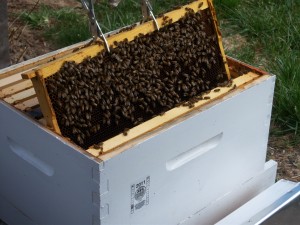 Yesterday I did a big spring inspection. For the first time since adding the second brood boxes to my two hives last summer, I inspected both the upper and the lower boxes. Boston, always the busier hive, had more bees, still lots of honey, some new brood and a little space to expand on the outer frames. I switched the boxes, putting the lower box on top. It was definitely lighter and had more space. I took some pictures as I went and the whole process took about 45 minutes. Because it was 70 degrees, I don’t think the bees minded too much. I never saw either queen, but there was new brood, so she is laying. As careful as I could be, there are still casualties replacing frames and moving boxes around like I did, and I can only hope that the queen is OK. There is always that risk. I didn’t swap the boxes on Anaheim hive, as there was more room in the top box, but I think I will swap them in a few weeks.
Yesterday I did a big spring inspection. For the first time since adding the second brood boxes to my two hives last summer, I inspected both the upper and the lower boxes. Boston, always the busier hive, had more bees, still lots of honey, some new brood and a little space to expand on the outer frames. I switched the boxes, putting the lower box on top. It was definitely lighter and had more space. I took some pictures as I went and the whole process took about 45 minutes. Because it was 70 degrees, I don’t think the bees minded too much. I never saw either queen, but there was new brood, so she is laying. As careful as I could be, there are still casualties replacing frames and moving boxes around like I did, and I can only hope that the queen is OK. There is always that risk. I didn’t swap the boxes on Anaheim hive, as there was more room in the top box, but I think I will swap them in a few weeks.
Google photo album: Honeybees 2012 Mar
Because of the warm winter, the new packages coming from Georgia will be arriving this weekend which is a couple of weeks earlier than usual. I still need to put some deep frames together, but otherwise I am ready for them. Because of the early start, I will need to feed them a lot until the nectar flow starts. I am really hoping for a strong flow and good weather during the Black Locust bloom. Losses of hives is typically in the 30% to 40% range, but it looks like my two made it. It’s a little too early to be sure, but unless we get an extended cold snap, I feel pretty good about my hives making it.

Bees in January
0We have had some very mild days recently. As a beekeeper, these days are particularly noteworthy. We all enjoy a nice day in January, but for the honeybees it can be a lifesaver. I think they have enough food to get through the winter, but I’m not sure about that and a warm day is a chance to add a snack. I have enough bee candy to provide a couple more mid-winter snacks. From what I have heard and read March is the toughest month for the bees. They will be running low on food, there is no outside source yet and the stress of the winter is probably at its maximum. I hope to save at least one snack and find a warm day in March to feed, but the weather will decide.
I also recently put up a wind screen which might help to prevent some heat loss and prevent the vicious north and west winds from blowing my hives over.
Last Sunday was a beautiful day in the 60s, so I opened each hive and added some candy. For some reason, I ended up leaving both feeders on, one on top of the inner cover and one under the inner cover. Some of the candy is a bit too thick to lay on the frames under the inner cover, so I put that candy in the feeder. I am hoping that there will be enough warm days for the bees to climb up into the feeder even if I don’t see them flying about outside of the hive. It looks like there is a good population of bees in both hives. It’s hard to separate the candy from the wax paper, so I just put the candy and paper in the hive and they drag the wax paper out. In a way, when the hive is closed, it is some tangible and comforting evidence that the bees are eating.So the hive is closed now and only Mother Nature know when I will get my next chance to feed.

Preparing chickens for winter
0We are having a nice little warm spell this past week and it should continue for several more days. This is great for preparing for winter. I can’t forget that a couple of weeks ago we had a small blizzard. Winter is on the way, no doubt about that. So while the weather is in the 60s and sunny, I should be winterizing the garden, the bees and the chickens.
I found a great article about ‘winterizing’ the chickens in a blog at The Guardian, so rather than reword and retype, I will just reference. The article is full of great information, which will spur me to action right after lunch and a nap.
The article talks about sub-zero temperature which we rarely have, so our chickens will be fine, but we do need to put up a little more plastic wrap around the coop screens just to keep the wind, rain, and snow at bay. Ventilation has never been a problem and the new chicken palace was designed with plenty of air flow. We may still want to move the chickens around between the three coops, but with four roosters creating new groups is tricky.
Our two-and-a-half-year-olds are all still in the middle of a big molt and I am hoping that they develop their new feathers soon. They look awful, but more importantly, they are very vulnerable to the cold in this condition. Percy is one of them, and along with the loss of feathers, he has clearly lost his mojo. He was the alpha bird until the molt and how he will run and hide if put in the same space as the new, much smaller, Tarick. We really should just get rid of Tarick. We are not planning to breed with him, and poor Percy would sure like to get his old space back.

Farm in November
0Garden
As the weather has been wet and cool, growth in the garden has slowed to a crawl. Surprisingly, the okra continues to make new flowers and fruits. The okra has been such a great crop. We will definitely grow some next season. The cherry tomatoes finally made their comeback after the rain stopped and we got some sun. I have been able to pick as many to eat as I want, which is how most of them are consumed. I sometimes bring a bowl full into the house, but they never seem as good as when I pick them right off the plants. The peppers are perhaps the most durable and fruitful of all the late garden plants. We always have lots of peppers left when the first frost arrives – which it did just a few days ago. Sadly, it was a pretty good freeze – at least five degrees below freezing – and all the plants took it pretty hard. To make matters worse the freeze has continued for four or five nights straight. Any chance that a slightly protected plant might have survived is now gone. All the tomatoes are mush as are all the peppers. I picked just a few tomatoes and peppers to bring in, blanch, peel, and put in a big pot of chili. The was the End-Of-The-Garden Memorial Chili Dinner. I think it should be the start of a new tradition.
Honeybees
The bees better be preparing for winter. I keep feeding them, but I don’t really want to open up the hives to see what is happening in there. I fear that the disruption in honey production might be worse than my fears of not knowing. Next year I will definitely do a few things differently. I really like the idea of getting some kind of relative weight throughout the season. I think I will take the advice of one of the bee club members and put a scale under the back edge of the hive every time I go out to look or feed and record that. I’m not sure what conclusions I will be able to draw, but I will at least have some data to work with.After the past several nights of freezing weather, the bees still are very active on a day like this where it is around 60 degrees and sunny. I have seen them on my mums and they are still bringing in pollen. I really don’t understand what happens to the population around this time of year. I suppose it decreases as they make room for more honey then brood. I need to get back to the books and remind myself that I still have a lot to learn.
Chickens
We finally got the palace chicken yard fenced in, but still need to build the gate. That’s what I should be doing today while it is so nice. They are making the most of the yard now and it looks like it could use some time off. I didn’t think that the 21 birds would eat down the grass so much, but they have and it needs a break. I guess this means that I will need to fence in the alternate yard early next spring. It was always the plan to have two separate areas that we could release the chickens into. The fencing project was more expensive than I had thought, but it really is a lot nicer than the fencing around the original coop. So if we can fence in a second area (to the south and west of the palace), it should really help the grass recover. Maybe we can move them every couple of weeks.
The Ameraucanas who laid a couple of eggs early and then stopped for a month, finally started to lay again and have been quite regular now. They are also bigger eggs than most of the light brown layers. I was hoping that by now all the eggs would be full sized, but I don’t think they are. Hopefully when they get rolling in the spring, they will be fully mature. I have been trading eggs for baked good with some of my yoga students and have sold a few dozen, but we will need a bunch of regular customers to keep up with all the eggs in the spring. And, of course, I want some more chickens next year, too. We will try to mate the Marans to get some more chocolate eggs, but will need to buy a few more Ameraucanas as we are lacking a rooster. Our two new roosters, Duran and Big Red have come to accept each other with no show of fighting. Early on Duran was clearly the boss, but more recently if either of them mounts a hen, the other will run over to ‘assist’ or at least encourage the act. I never imagined this kind of cooperation among the roosters.In the old coop, Percy is finishing his molt and might be getting his mojo back. Since the molting started, Tarick the younger, smaller rooster has been terrorizing Percy. Percy has been the clear boss up until this molt, but Tarick has been making up for lost time. We have had to protect Percy by putting him in the nursery coop out of Tarick’s reach. Before doing that poor Percy was hiding in the nest boxes – very unrooster-like. But finally Percy is beginning to show signs of being frisky again when we step into the nursery coop to supply food and water. I almost forgot to mention that Percy also had a broken spur. We discovered it one day because his foot was bloody. It seems as though the spur sloughed off of the bone. I didn’t realize this but I guess the spur is kind of a covering on a much smaller bone. I don’t know if this broken spur is related to the molt or not, but the combination sure seems to have taken all the aggression out of Percy. Joni did a great job of cleaning and bandaging his leg to protect the spur bone for several days and it looks to be healing well. It will be interesting to see if Percy can regain his stature as head rooster or if his reign is over.
